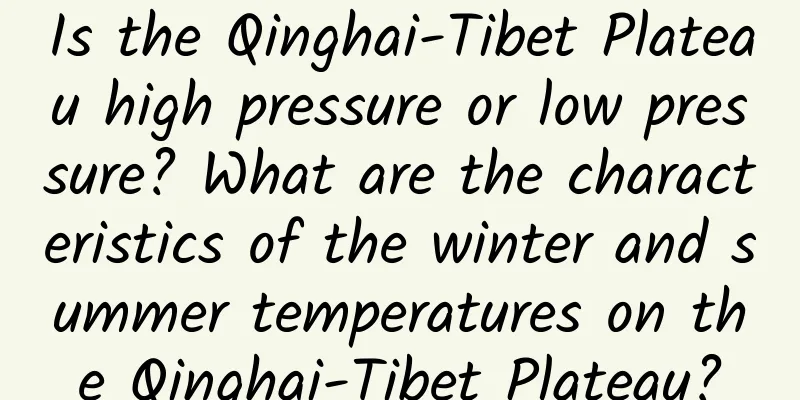Is the Qinghai-Tibet Plateau high pressure or low pressure? What are the characteristics of the winter and summer temperatures on the Qinghai-Tibet Plateau?

|
People feel chest tightness and difficulty breathing on the Qinghai-Tibet Plateau. Low air pressure on the plateau is only a basic reason. The main reason is that low air pressure makes the oxygen content in the air much lower than that in the plains, and even lower than the lower limit of oxygen content required by the human body. In this case, the human body cannot get enough oxygen and must make adjustments such as increasing breathing frequency, increasing lung capacity, etc. to meet the body's need for oxygen, which can easily cause altitude sickness. What are the characteristics of winter and summer temperatures on the Qinghai-Tibet Plateau? Let's take a look at the introduction of Encyclopedia Knowledge Network. Contents of this article 1. Is the Qinghai-Tibet Plateau high pressure or low pressure? 2. Is the Qinghai-Tibet Plateau the roof of the world? 3. What are the characteristics of winter and summer temperatures on the Qinghai-Tibet Plateau? 1Is the Qinghai-Tibet Plateau high pressure or low pressure?The Qinghai-Tibet Plateau is high in terrain, so the mass of the air column above it is smaller than that in the plains, which also makes the air pressure lower than that in the plains. People feel chest tightness and difficulty breathing on the Qinghai-Tibet Plateau. The low air pressure on the plateau is only a basic reason. The main reason is that the low air pressure makes the oxygen content in the air much lower than that in the plains, and even lower than the lower limit of oxygen content required by the human body. In this case, the human body cannot get enough oxygen and needs to make adjustments, such as increasing the breathing rate, increasing the lung capacity, etc. to meet the body's need for oxygen, which can easily cause altitude sickness. 2Is the Qinghai-Tibet Plateau the roof of the world?The Qinghai-Tibet Plateau is the roof of the world. It is the largest plateau in China and the highest in the world. It stretches from the southern edge of the Himalayas in the south to the northern edge of the Kunlun Mountains, the Altun Mountains and the Qilian Mountains in the north. The Pamir Plateau and the Karakoram Mountains are in the west, and the western section of the Qinling Mountains and the Loess Plateau in the east and northeast. It lies between 26°00′~39°47′ north latitude and 73°19~104°47′ east longitude. The Qinghai-Tibet Plateau is about 2,800 kilometers long from east to west and about 300 to 1,500 kilometers wide from north to south, with a total area of about 2.5 million square kilometers. It can be divided into six parts: the northern Tibetan Plateau, the southern Tibetan Valley, the Qaidam Basin, the Qilian Mountains, the Qinghai Plateau and the Sichuan-Tibet alpine canyon area. It includes all of Tibet in China and parts of Qinghai, Xinjiang, Gansu, Sichuan, Yunnan, as well as part or all of Bhutan, Nepal, India, Pakistan, Afghanistan, Tajikistan and Kyrgyzstan. 3What are the characteristics of winter and summer temperatures on the Qinghai-Tibet Plateau?The overall natural environment of the Qinghai-Tibet Plateau is characterized by high altitude and cold weather. Winter: The temperature is cold. The Qinghai-Tibet Plateau is a cold source in winter. The surrounding atmosphere transfers heat to the plateau ground-air system, with the largest amount in December and January. A cold high pressure is formed in the middle layer, and the cold air sinks, strengthening the East Asian winter monsoon. In winter, the cold area of the Qinghai-Tibet Plateau is biased towards the west. Summer: The temperature is cool. In summer, the Qinghai-Tibet Plateau is a powerful heat source, transferring heat to the surrounding atmosphere, with the largest amount in June and July. A thermal low pressure is formed on the ground, the air rises, and a warm high pressure is formed in the upper air, namely the Qinghai-Tibet High Pressure, which strengthens the southwest monsoon and the southeast monsoon. The warm area in summer is wide. |
>>: When is the orange season? The benefits and functions of green oranges
Recommend
What to do if a pregnant woman has plantar warts on her feet
Pregnant women will encounter many problems durin...
What are the symptoms of kidney failure in women?
If the condition is good, you still need to be mo...
What should women pay attention to during their menstrual period? Remember the three most important points
Women must know how to take care of themselves in...
Check out the sex positions during pregnancy
A woman should not have sexual activity with her ...
What to do if you have amenorrhea at the age of 39
Menstruation is a physiological phenomenon unique...
Will eating persimmons cause kidney stones? Is white frost a preservative? You must know these facts about persimmons!
Recently, it is the season for persimmons. Persim...
Is radiofrequency ablation a major surgery?
Many diseases require surgical treatment to be cu...
The fastest way to naturally enlarge your breasts
Breast augmentation is an essential topic that wo...
Why do those born after 1995 quit their jobs so easily? How can we make current employees more stable?
Post-95s pursue individuality and freedom, and li...
What causes itching after childbirth?
After giving birth, the mother's body is in a...
What to do if one side of the fallopian tube is blocked
One side of the fallopian tube is blocked. Whethe...
Yuanxiao and tangyuan are different, and sugar-free ones are not healthier
Yuanxiao (Chinese dumplings) and glutinous rice b...
Why do pregnant women have a lot of eye mucus?
Excessive eye mucus in pregnant women may be caus...
What to do if the follicle does not rupture
I believe everyone should have a certain understa...









